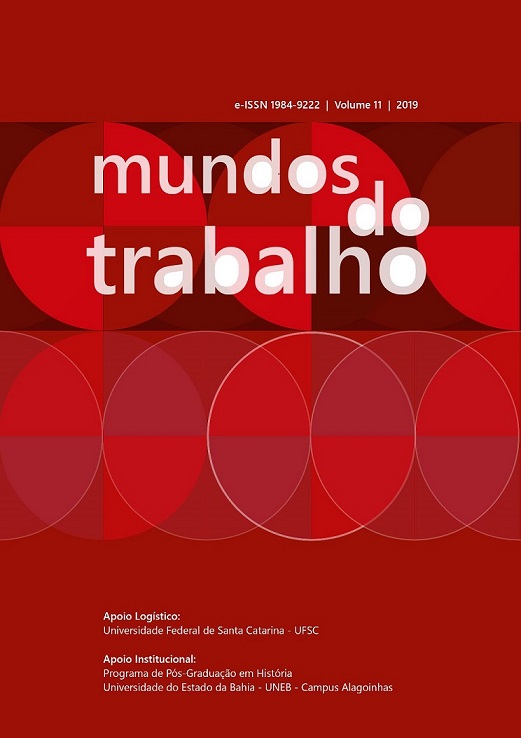Diferenças fatais: suicídio, raça e trabalho forçado nas Américas
DOI:
https://doi.org/10.5007/1984-9222.2019.e67255Resumo
Neste ensaio, examino a relação entre raça e suicídio nas Américas. Mostro como as ideias sobre suicídio ajudaram a gerar e reforçar várias formas de diferença racial e demonstro como as ideias coloniais sobreviveram por muito tempo após a independência e a abolição da escravidão, geralmente em novas formas. A historiografia existente sobre suicídio enfatiza respostas morais, religiosas e médicolegais à autodestruição. Menos atenção foi dada à raça ou ao fato brutal, amplamente reconhecido (embora raramente discutido em profundidade) pelos estudiosos da escravidão, que a servidão forçada também transformou o suicídio em uma questão essencialmente econômica – uma ameaça aos resultados dos plantadores e comerciantes e uma ameaça à produção. À medida que a escravidão e o trabalho forçado se tornavam sistemas de valores globais dominantes que determinavam quem contava como humano, a capacidade de perecer pelas próprias mãos se tornou um meio de vencer essa determinação. Em algum momento, histórias excepcionais de suicídio heroico de mártires nativos ou negros passaram a fazer parte de narrativas nacionais, mas esse processo dependia da dissociação entre autodestruição e produção econômica, o que ajudou a transformar atos, antes vistos como ameaça às fundações coloniais, em histórias de sacrifício e nascimento nacional. Com o tempo, e apesar das mudanças significativas, a autodestruição funcionou consistentemente como um marcador duradouro da diferenciação racial.
Referências
ALBUQUERQUE, João. “The Brazilian Theatre up to 1900”, in Roberto González Echevarría e Enrique Pupo-Walker (orgs.), The Cambridge History of Latin American Literature, vol. 3: Brazilian Literature; Bibliographies (Cambridge, 1996), pp. 105–125
ALCHON, Suzanne Austin. A Pest in the Land: New World Epidemics in a Global Perspective (Albuquerque, N.Mex., 2003).
ALENCAR, José Martiniano de. Iracema: A Novel, traduzido por Clifford E. Landers (Nova York, 2000).
ANDREWS, George Reid. The Afro-Argentines of Buenos Aires, 1800–1900 (Madison, Wis., 1980).
ARMISTEAD, Wilson. A Tribute for the Negro: Being a Vindication of the Moral, Intellectual, and Religious Capabilities of the Coloured Portion of Mankind; with Particular Reference to the African Race (Manchester, 1848).
AZEVEDO, Célia M. Marinho de. Abolitionism in the United States and Brazil: A Comparative Per- spective (Nova York, 1995).
BAECHLER, Jean. Suicides, traduzido por Barry Cooper (Nova York, 1979).
BARBOT, Jean. Barbot on Guinea: The Writings of Jean Barbot on West Africa, 1678–1712, ed. Paul Hair, Adam Jones, e Robin Law, 2 vols. (Londres, 1992), vol. 2.
BATES, Henry Walter. Central America, the West Indies and South America, 3a. ed. (Londres, 1885).
BEATTIE, Peter M. Punishment in Paradise: Race, Slavery, Human Rights, and a Nineteenth-Century Penal Colony (Durham, N.C., 2015).
BEHM, Amanda. “Settler Historicism and Anticolonial Rebuttal in the British World, 1880–1920”, Journal of World History, vol. 26, no. 4 (2015), pp. 785–813.
BEHN, Mrs. A. Oroonoko; or, The Royal Slave: A True History (Londres, 1688).
BELL, Richard. We Shall Be No More: Suicide and Self-Government in the Newly United States (Cambridge, Mass., 2012).
BELTRÁN, Gonzalo Aguirre. La población negra de México: Estudio etnohistorico (Cidade do México City, 1972).
BORGES, Dain. “The Recognition of Afro-Brazilian Symbols and Ideas, 1890– 1940”, Luso-Brazilian Review, vol. 32, no. 2 (1995), pp. 59–78.
BRONFMAN, Alejandra. Measures of Equality: Social Science, Citizenship, and Race in Cuba, 1902–1940 (Chapel Hill, N.C., 2004).
BROWN, Vincent. “Spiritual Terror and Sacred Authority in Jamaican Slave Society”, Slavery and abolition, vol. 24, no. 1 (2003), pp. 24–53.
BROWN, Vincent. The Reaper’s Garden: Death and Power in the World of Atlantic Slavery (Cambridge, Mass., 2007).
CALVO, Lino Novás. “El pathos cubano”, in José María Chacón y Calvo (org.), Homenaje a Enrique Jos´e Varona en el cincuentenario de su primer curso de filosofía (1880–1930): Miscelanea de estudios literarios, históricos y filosóficos (Havana, 1935), pp. 211–226.
CANÁRIO, Ezequiel David do Amaral. “E, mais uma scena da escravidão”: suicídios de escravos na cidade do Recife, 1850–1888 (Recife, Brasil, 2011).
CARNEIRO, Edison. O quilombo do Palmares, 1630–1695 (São Paulo, 1947). CHAPMAN, Charles E. “The Negro Numantia”, Journal of Negro History, vol. 3, no. 1 (1918), pp. 29–32.
Chinese Emigration: The Cuba Commission (Report of the Commission Sent by China to Ascertain the Condition of Chinese Coolies in Cuba) (Taipei, 1970; originalmente publicado em 1876).
CONRAD, Robert Edgar. Children of God’s Fire: A Documentary History of Black Slavery in Brazil (1983; reeditado pela University Park, Pa., 1994).
COWLEY, Rafael (org.). Los tres primeros historiadores de la isla de Cuba, 3 vols. (Havana, 1876), vol. 1.
COWLING, Camillia. Conceiving Freedom: Women of Color, Gender, and the Abolition of Slavery in Havana and Rio de Janeiro (Chapel Hill, N.C., 2013).
DAY, Thomas; BICKNELL, John. The Dying Negro: A Poetical Epistle (Londres, 1773).
DE LA BARRA, Felipe. El indio peruano en las etapas de la conquista y frente a la republica (Lima, 1948).
DENIS, Adrián López. “Melancholia, Slavery, and Racial Pathology in Eighteenth-Century Cuba”, Science in Context, vol. 18, no. 2 (2005), pp. 179–199.
DUKE, Dawn. Literary Passion, Ideological Commitment: Toward a Legacy of Afro-Cuban and Afro-Brazilian Women Writers (Lewisburg, Pa., 2008).
EARLE, Rebecca. The Return of the Native: Indians and Myth-Making in Spanish America, 1810–1930 (Durham, N.C., 2007).
EWBANK, Thomas. Life in Brazil; or, A Journal of a Visit to the Land of the Cocoa and the Palm, Nova York, 1856.
FARAGE, Nadia. As muralhas dos sertões: os povos indígenas no Rio Branco e a colonização (Rio de Janeiro, 1991).
FERREIRA, Jackson. “‘Por hoje se acaba a lida’: suicídio escravo na Bahia (1850–1888)”, Afro-Ásia, no. 31 (2004), pp. 197–234.
FRANÇA, Jean Marcel Carvalho; FERREIRA, Ricardo Alexandre. Três vezes Zumbi: A constru¸ção de um heroi brasileiro (São Paulo, 2012).
FRANCO, José L. “Maroons and Slave Rebellions in the Spanish Territories”, in Richard Price (org.), Maroon Societies: Rebel Slave Communities in the Americas, 3rd ed. (Baltimore, 1996), pp. 35–48.
FREYRE, Gilberto. The Masters and the Slaves (Casa-grande & senzala): A Study in the Development of Brazilian Civilization, tradução de Samuel Putnam (Nova York, 1946).
FROUDE, James Anthony. Short Studies on Great Subjects (Nova York, 1868).
GALINDO, Alberto Flores. Aristocracia y plebe: Lima, 1760–1830 (Estructura de clases y sociedad colonial) (Lima, 1984).
GERMETEN, Nicole von. “Archival Narratives of Clerical Sodomy and Suicide from Eighteenth-Century Cartagena”, in Zeb Tortorici (org.), Sexuality and the Unnatural in Colonial Latin America (Berkeley, Calif., 2016), pp. 23–42.
GOLDENWEISER, Alexander. “Race and Culture in the Modern World”, Journal of Social Forces, vol. 3, no. 1 (1924), pp. 127–136.
GOMES, Flávio dos Santos (org.), Mocambos dos Palmares: Histórias e fontes (s´ec. XVI–XIX) (Rio de Janeiro, 2010).
GOMES, Flávio dos Santos. De olho em Zumbi dos Palmares: Histórias, símbolos e memória social (São Paulo, 2011).
GOMEZ, Michael A. “A Quality of Anguish: The Igbo Response to Enslavement in North America,” in Paul E. Lovejoy e David V. Trotman (orgs.), Trans-Atlantic Dimensions of Ethnicity in the African Diaspora (Londres, 2003), pp. 82–95.
GOMEZ, Michael A. Exchanging Our Country Marks: The Transformation of African Identities in the Colonial and Antebellum South (Chapel Hill, N.C., 1998), pp. 117– 118.
GRADEN, Dale T. “History and Motive as Seen through Antônio Frederico de Castro Alves’s ‘Saudação a Palmares’”, Brasil/Brazil vol. 6, no. 9 (1993), pp. 27–45.
HELTON, Laura. Justin Leroy, Max A. Mishler, Samantha Seeley, e Shauna Sweeney, “The Question of Recovery: An Introduction”, Social Text, vol. 33, no. 4 (2015), pp. 1–18.
HEMMING, John. Red Gold: The Conquest of the Brazilian Indians (Londres, 1978).
HEWITT, Julia Cuervo. Voices out of Africa in Twentieth-Century Spanish Caribbean Literature (Lewis- burg, Pa., 2009).
HOGARTH, Rana Asali. “Comparing Anatomies, Constructing Races: Medicine and Slavery in the Atlantic World, 1787–1838” (Tese de Doutorado, Universidade de Yale, 2012).
HÜNEFELDT, Christine. Paying the Priec of Freedom: Family and Labor among Lima’s Slaves, 1800-1854 (Berkeley, Calif., 1994).
KIDDER. D. D.; FLETCHER, J. C. Brazil and the Brazilians, Portrayed in Historical and Descriptive Sketches (Philadelphia, 1857).
KOSLOFSKY, Craig M. “Controlling the Body of the Suicide in Saxony”, in Watt, From Sin to Insanity, pp. 48–63.
LARA, Silvia Hunold. “Do singular ao plural: Palmares, capitães-do-mato e o governo dos escravos”, in João José Reis e Flávio dos Santos Gomes (orgs.), Liberdade por um fio: História dos quilombos no Brasil (São Paulo, 1996), pp. 81–109.
LAS CASAS, Bartolomé de. A Short Account of the Destruction of the Indies, tradução de Nigel Griffin (Londres, 1992).
LAS CASAS, Bartolomé de. Historia de las Indias, 3 vols. (Madri, 1875), vol. 2.
LATOUR, Antonio Chuffat. Apunte histórico de los chinos en Cuba
(Havana, 1927).
LEANTE, Ce´sar. Los guerrilleros negros (Cidade do México, 1979).
LESSER, Jeffrey. Negotiating National Identity: Immigrants, Minorities, and the Struggle for Ethnicity in Brazil, Durham, N.C., 1999.
LOAYZA, Francisco A. Cahuide no existiu:: Ensayo crítico-histórico, basado en antiguos documentos irrefutables (Lima, 1944).
LOAYZA, Francisco A. Cahuide no se llamó Cahuide: Ensayo crítico-histórico, basado en antiguos documentos irrefutables (Lima, 1948).
LOPES, Fábio Henrique. “O suicídio como perigo social e urbano: As teses médicas brasileiras”, Revista do Instituto Histórico e Geográfico Brasileiro, vol. 169, no. 438 (2008), pp. 91–112.
LÓPEZ, Kathleen. “Afro-Asian Alliances: Marriage, Godparentage, and Social Status in Late- Nineteenth-Century Cuba”, Afro-Hispanic Review, vol. 27, no. 1 (2008), pp. 59–72.
LORENTE, Sebastián. Historia de la conquista del Perú (Lima, 1861).
LOWE, Lisa. “History Hesitant”, Social Text, vol. 33, no. 4 (2015), pp. 85–107.
LUIS, William. Literary Bondage: Slavery in Cu- ban Narrative (Austin, Tex., 1990).
MACDONALD, Michael; MURPHY, Terence R. Sleepless Souls: Suicide in Early Modern England (Oxford, 1990).
MACHADO, Maria Helena. O plano e o pânico: Os movimentos sociais na década da abolição (Rio de Janeiro, 1994).
MALVIDO, Elsa. “El suicidio entre los esclavos negros en el Caribe en general y en el franc´es en par- ticular: Una manera de evasión considerada enfermedad, siglos XVII y XVIII”, Trace, no. 58 (2010), pp. 113– 124, http://trace.revues.org/1577.
MARKHAM, Clements R. Cuzco: A Journey to the Ancient Capital of Peru (Londres, 1856).
MARTIN, Bonnie. “Slavery’s Invisible Engine: Mortgaging Human Property”, Journal of Southern History, vol. 76, n. 4 (2010), pp. 817–866.
MINOIS, Georges. History of Suicide: Voluntary Death in Western Culture, traduzido por Lydia G. Cochrane (Baltimore, 2001).
MONTEJO, Esteban. The Autobiography of a Runaway Slave, ed. Miguel Barnet, traduzido por Jocasta Innes (Nova York, 1968).
MONTOYA, Antonio Ruiz de. The Spiritual Conquest Accomplished by the Religious of the Society of Jesus in the Provinces of Paraguay, Parana, Uruguay, and Tape, traduzido por C. J. McNaspy, John P. Leonard, e Martin E. Palmer (St. Louis, Mo., 1993).
MONTOYA, Arturo. “Cahuide,” in Montoya, Medallones (Lima, 1898).
MORRISSEY, Susan K. “Drinking to Death: Suicide, Vodka and Religious Burial in Russia”, Past and Present, no. 186 (fevereiro de 2005), pp. 117–146.
NABUCO, Joaquim. A escravidão (1870) (Recife, 1988).
NABUCO, Joaquim. O direito do Brasil (São Paulo, 1949).
NARO, Nancy Priscilla. A Slave’s Place, a Master’s World: Fashioning Dependency in Rural Brazil (Nova York, 2000).
O’DEA, James J. Suicide: Studies on Its Philosophy, Causes, and Prevention (Nova York, 1882).
ODA, Ana Maria Galdini Raimundo. “Escravidão e nostalgia no Brasil: o banzo”, Revista latinoamericana de psicopatologia fundamental, vol. 11, no. 4 (2008), pp. 735–761.
OHNUKI-TIERNEY, Emiko. Kamikaze, Cherry Blossoms, and Nationalisms: The Militarization of Aesthetics in Japanese History (Chicago, 2002).
OLIVEIRA, Saulo Veiga. “O suicídio de escravos em Campinas e na província de São Paulo (1870–1888)” (Dissertação de Mestrado, Universidade Estadual de Campinas, 2007).
ORTIZ, Fernando. Hampa afro-cubana: Los negros esclavos, studio sociológico y de derecho publico (Havana, 1916).
ORTIZ, Fernando. Los negros brujos (Havana, 2007).
PAQUETTE, Robert L. Sugar Is Made with Blood: The Conspiracy of La Escalera and the Conflict between Empires over Slavery in Cuba (Middletown, Conn., 1988).
PÉREZ JR., Louis A. To Die in Cuba: Suicide and Society, Chapel Hill, N.C., 2005.
PHAF-RHEINBERGER, Ineke. “Introduction” to “A Mosaic Setting: A Contrastive History of Genre”, in A. James Arnold (org.), A History of Literature in the Caribbean, vol. 2: English- and Dutch-Speaking Countries (Amsterdam, 2001), pp. 471–477.
PIERSEN, William D. “White Cannibals, Black Martyrs: Fear, Depression, and Religious Faith as Causes of Suicide among New Slaves”, Journal of Negro History, vol. 62, no. 2 (1977), pp. 147–159.
PITA, Sebastião da Rocha. História da América portuguesa (1730; repr., São Paulo, 1976).
PRESCOTT, William H. History of the Conquest of Peru, ed. Wilfred Harold Munro, 3 vols. (Philadelphia, 1904).
PRESCOTT, William Hickling. Historia de la conquista del Perú: Con observaciones preliminares sobre la civilización de los Incas (Madrid, 1853).
PRUDHOMME, Charles. “The Problem of Suicide in the American Negro,” Psychoanalytic Review, vol. 25, no. 2 e 3 (1938), pp. 187–204, 372–391.
PUTNAM, Lara. “The Transnational and the Text-Searchable: Digitized Sources and the Shadows They Cast”, American Historical Review, vol. 121, no. 2 (abril de 2016), pp. 377–402.
REIS, Andressa Mercês Barbosa dos. “Zumbi: Historiografia e imagens” (Dissertação de Mestrado, Universidade Estadual Paulista–Campus de Franca, 2004).
REIS, Arthur Cézar Ferreira. História do Amazonas (1931; 2a ed., Belo Horizonte, Brasil, 1989).
REIS, José Roberto Franco. “Higiene mental e eugenia: o projeto de ‘Regeneração Nacional’ da Liga Brasileira de Higiene Mental (1920–30)” (Dissertação de Mestrado, Universidade Estadual de Campinas, 1994).
REYES-FOSTER, Beatriz; KANGAS, Rachael. “Unraveling Ix Tab: Revisiting the ‘Suicide Goddess’ in Maya Archaeology”, Ethnohistory, vol. 63, no. 1 (2016), pp. 1–27.
RODRIGUES, Raymundo Nina. “A troya negra: Erros e lacunas da história de Palmares”, Revista do Instituto arqueológico e geográfico pernambucano, vol. 11, n. 63 (1904), pp. 645–672.
ROSSEL, Rafael Azcarate. Historia de los indios de Cuba (Havana, 1937).
RUSTIC, Jane [Frances Ellen Watkins Harper]. “Zombi, or Fancy Sketches”, Anglo-African Magazine, fevereiro de 1860, pp. 33–37.
SACO, José Antonio. Historia de la esclavitud de la raza africana en el Nuevo mundo y en especial en los paises am´erico-hispanos (Barcelona, 1879).
SCHWARTZ, Stuart B. Slaves, Peasants, and Rebels: Reconsidering Brazilian Slavery (Urbana, Ill., 1996).
SNYDER, Terri L. “Suicide, Slavery, and Memory in North America”, Journal of American History, vol. 97, no. 1 (2010), pp. 39–62.
SNYDER, Terri L. “What Historians Talk about When They Talk about Suicide: The View from Early Modern British North America”, History Compass, vol. 5, no. 2 (2007), pp. 658–674.
SNYDER, Terri L. The Power to Die: Slavery and Suicide in British North America, Chicago, 2015.
SOMMER, Doris. Foundational Fictions: The National Romances of Latin America, Berkeley, Calif., 1993.
SUÁREZ Y ROMERO, Anselmo. Francisco, el ingenio; o, Las delicias del campo: Novela cubana (1947; reeditado, Miami, 1969).
SWEET, David Graham. “A Rich Realm of Nature Destroyed: The Middle Amazon Valley, 1640–1750” (Tese de Doutorado, Universidade de Wisconsin–Madison, 1974).
THURNER, Mark. History’s Peru: The Poetics of Colonial and Postcolonial Historiography (Gainesville, Fla., 2012).
TORTORICI, Zeb. “Reading the (Dead) Body: Histories of Suicide in New Spain”, in Martina Will de Chaparro e Miruna Achim (orgs.), Death and Dying in Colonial Spanish America (Tucson, Ariz., 2011), pp. 53–77.
TSCHUDI, J. J. von. Travels in Peru, during the Years 1838–1842, nova edição, traduzida por Thomasina Ross (Nova York, 1852).
UNANUE, Hipólito. Observaciones sobre el clima de Lima, y sus influencias en los seres organizados, en especial el hombre (Lima, 1806).
VENÂNCIO, Renato Pinto. “A última fuga: suicídio de escravos no Rio de Janeiro (1870–1888)”, LPH/Revista de História no.1 (1990), pp. 80–89.
VENÂNCIO, Renato Pinto; LANNA, Maria Célia da S. “Banzo: desnutrição e morte do escravo”, Ciência hoje 21, no. 126 (1997), pp. 42–47.
VILLAVERDE, Cirilo. Cecilia Vald´es, or El Angel Hill, ed. Sibylle Fischer, traduzido por Helen Lane (Oxford, 2005).
WALSH, R. Notices of Brazil in 1828 and 1829, 2 vols. (Boston, 1831).
WATT, Jeffrey R. (org.), From Sin to Insanity: Suicide in Early Modern Europe (Ithaca, Nova York, 2004).
WEINSTEIN, Barbara. “Erecting and Erasing Boundaries: Can We Combine the ‘Indo’ and the ‘Afro’ in Latin American Studies?”, Estudios interdisciplinarios de América Latina y el Caribe, vol. 19, no. 1 (2008), pp. 129–144.
WEINSTEIN, Barbara. “The Decline of the Progressive Planter and the Rise of Subaltern Agency: Shifting Narratives of Slave Emancipation in Brazil”, in Gilbert M. Joseph (org.), Reclaiming the Political in Latin American History: Essays from the North (Durham, N.C., 2001), pp. 81–101.
WRIGHT, David; WEAVER, John. “Introduction”, in Weaver e Wright (orgs.), Histories of Suicide: International Perspectives on Self-Destruction in the Modern World (Toronto, 2009), pp. 3–18.
WRIGHT, Robin M.; CUNHA, Manuela Carneiro da. “Destruction, Resistance, and Transformation southern, Coastal, and Northern Brazil (1580–1890)”, in Frank Salomon e Stuart B. Schwartz (orgs.), The Cambridge History of the Native Peoples of the Americas, vol. 3: South America, Part 1 (Cambridge, 1999), pp. 287–381.
YUN, Lisa. The Coolie Speaks: Chinese Indentured Laborers and African Slaves in Cuba (Philadelphia, 2008).
Downloads
Publicado
Como Citar
Edição
Seção
Licença
Os autores cedem à Revista Mundos do Trabalho os direitos exclusivos de primeira publicação, com o trabalho simultaneamente licenciado sob a Licença Creative Commons Attribution (CC BY) 4.0 International. Esta licença permite que terceiros remixem, adaptem e criem a partir do trabalho publicado, atribuindo o devido crédito de autoria e publicação inicial neste periódico. Os autores têm autorização para assumir contratos adicionais separadamente, para distribuição não exclusiva da versão do trabalho publicada neste periódico (ex.: publicar em repositório institucional, em site pessoal, publicar uma tradução, ou como capítulo de livro), com reconhecimento de autoria e publicação inicial neste periódico.









